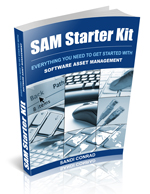Why Do I Need a Formal ITAM Practice?
 This article has been contributed by Sandi Conrad of Conrad & Associates.
This article has been contributed by Sandi Conrad of Conrad & Associates.
Sandi is the author of the “SAM Starter Kit” published by The ITAM Review.
Formalizing an ITAM practice to include a repeatable, auditing process is on most CIO’s lists of things to do. Unfortunately it’s often at the bottom of the list. Other technology projects take priority as they will help a business unit become more efficient, allow sharing or harvesting of information, or prevent a company from running into a disaster non-recovery nightmare. These projects are all important. However, the question that needs to be asked is why isn’t ITAM higher on the priority list?
We all know that there are only so many hours in a workday, only so many hands and minds available on the IT team, and only so much time available for purchasing or legal to deal with licensing matters. IT is often juggling multiple projects, so where is the incentive to add one more to the list? Especially one that no other business unit cares about? Or one that gets in the way of those other business units getting what they need?…right now?
From a budgeting and contract negotiation perspective, knowledge is power. If you know what contracts are due when, what purchases will need to be made throughout the year, what kind of support will be required and how many licenses are actually in use at any given time; you will be in a much stronger position to negotiate prices and specific terms required to customize a contract for your organization’s benefit.
If a software publisher or software watchdog group calls up looking for information, having it immediately available can prevent time consuming and costly audits. A medium sized organization (250-1000 PCs) without accurate records can expect a disruption of anywhere from 3 weeks to 6 months to respond appropriately to an audit request. Suddenly the priority is high to avoid litigation and the extra expense of an external auditor, which can significantly throw off other projects previously labelled as high priority.
Effectively managing lease returns and redeployed hardware and software also becomes much more challenging when a formal ITAM process isn’t in place. The costs of not returning hardware on time and of over purchasing hardware and software can become much higher than the cost of assigning a dedicated asset manager.
A few years ago, I worked with a large enterprise that had been buying software for each new employee based on a standard configuration. However, because they hadn’t worked through the entire asset management process, they didn’t realize they were not redeploying all of the assets. By guiding them through the asset management lifecycle and formalizing the process, we discovered the company was spending an extra $300,000 per year on extraneous software licenses. Creating a business case for ITAM was pretty easy after that.
 This article has been contributed by Sandi Conrad of Conrad & Associates. Sandi is the author of the “SAM Starter Kit” published by The ITAM Review.
This article has been contributed by Sandi Conrad of Conrad & Associates. Sandi is the author of the “SAM Starter Kit” published by The ITAM Review.
Sandi has been in the software business since 1991 and was one of the first Software Contract Administrators in Canada.
She has been providing consulting services since 1996, helping hundreds of clients to understand their obligations and rights under a myriad of contracts, and comparing licensing programs to find the most advantageous options for her clients.
~
Can’t find what you’re looking for?
More from ITAM News & Analysis
-
Broadcom vs Siemens AG - A Brewing Storm
The ongoing legal battle between VMware (under Broadcom ownership) and Siemens is yet another example of why ITAM goes far beyond license compliance and SAM. What might, at first glance, appear to be a licensing dispute, ... -
Shifting Left Together: Embedding ITAM into FinOps Culture
During one of the keynotes at the FinOps X conference in San Diego, JR Storment, Executive Director of the FinOps Foundation, interviewed a senior executive from Salesforce. They discussed the idea of combining the roles of ... -
Addressing the SaaS Data Gap in FinOps FOCUS 2.1
I recently reported on the FinOps Foundation’s inclusion of SaaS and Datacenter in its expanded Cloud+ scope. At that time, I highlighted concerns about getting the myriad SaaS companies to supply FOCUS-compliant billing data. A couple ...
Podcast
ITAM training
Similar Posts
-
The M&S Cyberattack: How IT Asset Management Can Make or Break Your Recovery
Marks & Spencer (M&S), the iconic UK retailer, recently became the latest high-profile victim of a devastating cyberattack. Fellow retailers The Co-Op and Harrods were also attacked. Recent reports suggest the rapid action at the Co-Op ... -
AI in ITAM: Insightful Signals from the Front Line
During our Wisdom Unplugged USA event in New York in March 2025, we engaged ITAM professionals with three targeted polling questions to uncover their current thinking on Artificial Intelligence—what concerns them, where they see opportunity, and ... -
How ISO/IEC 19770-1 Can Help Meet FFIEC Requirements
In the world of ITAM, the regulatory spotlight continues to intensify, especially for financial institutions facing increasing scrutiny from regulatory bodies due to the growing importance of IT in operational resilience, service delivery, and risk management. ... -
An Introduction to Scope 4 Emissions
Executive Summary For ITAM teams, sustainability is a core responsibility and opportunity. Managing hardware, software, and cloud resources now comes with the ability to track, reduce, and report carbon emissions. Understanding emission scopes—from direct operational emissions ...




